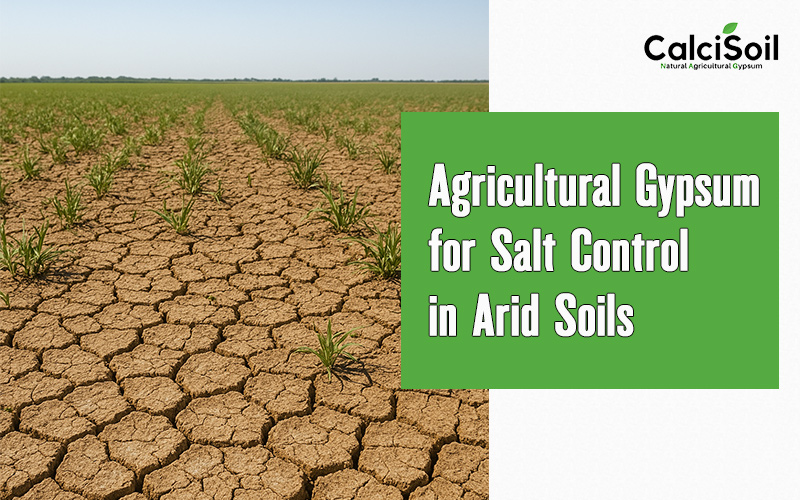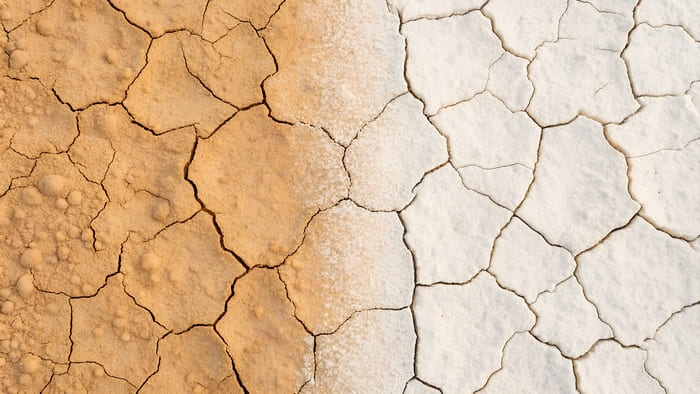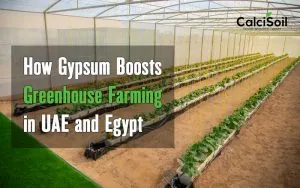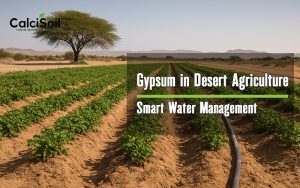
Agricultural Gypsum for Salt Control
(A Practical Guide for Farmers Seeking to Improve Soil Health in Hot Dry Environments)
Soil salinity is one of the most persistent and destructive challenges facing farmers and rangeland managers across arid regions such as the UAE, Saudi Arabia, Egypt, and North Africa. Intense temperatures, high evaporation rates, and saline irrigation water contribute to the formation of salt crusts on the soil surface. These crusts block seed germination, restrict water penetration, suffocate plant roots, and accelerate land degradation. Fortunately, agricultural gypsum—a naturally occurring soil amendment—has proven to be one of the most effective, affordable, and sustainable solutions for breaking up and managing salt crusts in dryland environments.
Understanding Why Salt Crusts Form
Salt crusts develop when dissolved salts rise to the soil surface through capillary movement and remain behind after water evaporates. In hot arid regions, this happens rapidly and repeatedly. Over time, the top layer becomes cemented, creating a hard, impermeable crust. This crust reduces infiltration, forcing irrigation water to run off instead of soaking into the soil. Seeds cannot emerge, roots cannot breathe, and the field gradually becomes unproductive.
This is where gypsum fertilizer plays a transformative role.

How Gypsum Helps Break Salt Crusts
Agricultural gypsum (calcium sulfate dihydrate) works by releasing calcium into the soil. Calcium replaces sodium on soil particles, the primary cause of crust formation and poor soil structure. As sodium is displaced and leached downward, the soil loosens, aggregates re-form, and the crust breaks apart naturally.
Unlike many chemical amendments, gypsum is safe, non-toxic, and long-lasting. It improves soil structure physically and chemically, making it one of the most recommended products by soil scientists for saline and sodic soils in arid climates. Farmers looking to buy agricultural gypsum often do so specifically for salt-crust reclamation because the results are visible even within one season.
Improving Infiltration and Water Use Efficiency
One of the immediate benefits of gypsum fertilizer is improved water infiltration. When the crust is broken and aggregates reform, irrigation water penetrates deeper into the soil profile instead of evaporating quickly. This helps reduce water waste—a critical advantage in desert agriculture where water is scarce and expensive. Better infiltration also supports deeper root growth and improves drought resilience, allowing plants to access moisture for longer periods.
In rangelands, where rainfall is minimal and unpredictable, gypsum helps ensure that every millimeter of rain is captured by the soil instead of being lost as surface runoff.
Supporting Plant Growth in Degraded Rangelands
Salt crusts suppress natural vegetation in rangelands, leading to land degradation and reduced forage availability for grazing animals. By applying agricultural gypsum, land managers can restore soil function and encourage the germination of native grasses. Better soil structure means improved aeration, stronger root systems, and higher organic matter accumulation over time.
This creates a more resilient rangeland ecosystem capable of withstanding drought cycles common in arid climates.
Application Methods for Maximum Results

To manage salt crusts effectively, gypsum should be applied evenly across the soil surface. Application rates vary depending on salinity levels, but common recommendations for arid regions are:
- Mild crusting: 1 ton per acre
- Moderate crusting: 2–3 tons per acre
- Severe sodicity or visible hardpan: 4 tons per acre over multiple applications
Gypsum can be broadcast manually, spread using mechanical applicators, or applied in soluble form through irrigation systems (fertigation). In drip systems, soluble gypsum helps protect the wetting zone from salt accumulation around emitters.
For best results, apply gypsum before rainfall or a major irrigation cycle. Water activates the gypsum, enabling calcium to move downward and displace sodium efficiently.
Long-Term Benefits of Gypsum in Arid Farms
Regular gypsum use is not only a short-term fix—it builds long-term soil resilience. Over several seasons, farmers observe:
- Reduced recurrence of salt crusts
- Improved soil tilth and aeration
- Lower salinity levels in the root zone
- Better water-holding capacity
- Increased microbial activity
- Higher yield stability
These long-term improvements make gypsum one of the most cost-effective soil conditioners available, especially for farmers in hot, dry regions where salt stress is a constant threat.
Economic Advantages for Farmers
Applying gypsum is significantly cheaper than replacing topsoil or implementing expensive desalination systems. It reduces crop losses, improves water-use efficiency, and maximizes the performance of fertilizers. For farmers looking to buy agricultural gypsum, it offers an excellent return on investment because it prevents long-term soil degradation and supports sustainable land use.
Conclusion
Salt crusts can devastate farmland and rangelands in arid regions, but they do not have to be permanent. With the right strategy and proper use of agricultural gypsum, farmers can reclaim degraded soils, enhance water infiltration, and restore productivity. Gypsum fertilizer is a scientifically proven, eco-friendly, and cost-effective solution that empowers growers to thrive even in harsh desert environments.







